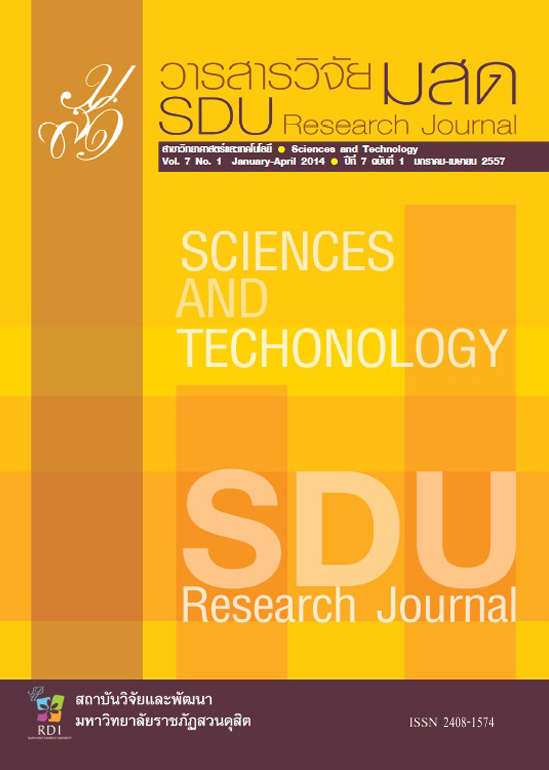การเจริญของเซลล์เมลาโนมาในการเพาะเลี้ยงในหลอดทดลองที่มีสารสกัดจากอินทนิลน้ำ (Lagerstroemia speciosa (L.) Per.)
Keywords:
เซลล์เมลาโนมา, สารสกัด, อินทนิลน้ำAbstract
บทคัดย่อ
อินทนิลน้ำ (Lagerstroemia speciosa (L.) Per.) หรือ Queen’s Flower เป็นพืชสมุนไพรที่พบในแถบเอเชียตะวันออกเฉียงใต้ และส่วนต่างๆ ของพืชสามารถรักษาโรคได้หลากหลาย เช่น โรคเบาหวาน โรคอ้วน นอกจากนี้มีการนำมาใช้ในเครื่องสำอางสำหรับผิวหนังและเส้นผม มีฤทธิ์ต้านอนุมูลอิสระนำมาใช้สำหรับผลิตภัณฑ์ปรับสีผิว ต้านริ้วรอย ฝาดสมานผิวและกระตุ้นการเจริญของเส้นผม การใช้ผลิตภัณฑ์เหล่านี้จะต้องสัมผัสกับผิวหนังโดยตรง ดังนั้นฤทธิ์ของสารสกัดที่มีผลต่อการเจริญของเซลล์จึงมีความสำคัญ งานวิจัยนี้จึงศึกษาการเจริญของเซลล์เมลาโนมาที่เพาะเลี้ยงในหลอดทดลองที่มีสารสกัดจากอินทนิลน้ำ โดยเซลล์เมลาโนมาถูกเลี้ยงด้วยจำนวนเริ่มต้น 2x105, 3x105 และ 4x105 เซลล์ต่อหลุม ในจานหลุม 6 หลุม (6-well tissue culture plate) ในอาหารชนิดดีเอ็มอีเอ็ม (DMEM, dulbecco’s modified eagle medium) ที่มีส่วนผสมของซีรั่มลูกวัว 10 % (10 % of fetal bovine serum) และถูกทดสอบกับสารอินทนิลน้ำที่ความเข้มข้น 1, 10 และ 100 µg/ml เซลล์ถูกเลี้ยงอยู่ที่อุณหภูมิ 37 องศาเซลเซียสและมีก๊าซคาร์บอนไดออกไซด์ 5 % เป็นเวลา 7 วัน ผลการศึกษาพบว่า เวลาที่เซลล์ใช้ในการเจริญเพิ่มจำนวนเป็นสองเท่า (Doubling time) มีค่าเฉลี่ย 70.03±8.26 ชั่วโมง และสารสกัดอินทนิลน้ำที่ความเข้มข้น 1 และ 10 µg/ml ไม่มีผลต่อการเจริญของเซลล์ และเวลาที่เซลล์ใช้ในการเจริญเพิ่มจำนวนเป็นสองเท่าไม่แตกต่างกับเซลล์ที่เลี้ยงในอาหารโดยไม่มีสารสกัด ส่วนสารสกัดอินทนิลน้ำที่ความเข้มข้น 100 µg/ml มีผลทำให้เซลล์เริ่มตายในวันที่ 3 ของการเลี้ยงเซลล์ เซลล์มีจำนวนลดลงอย่างมีนัยสำคัญทางสถิติp= 0.037 (p < 0.05) และสารดีเอ็มเอสโอที่ความเข้มข้น 0.0001, 0.001, 0.01% ที่ใช้ละลายสารอินทนิลน้ำ ไม่มีผลต่อการเจริญของเซลล์ ผลจากการวิจัยทำให้ทราบว่าความเข้มข้นของสารที่นำมาใช้มีผลต่อการเจริญของเซลล์ เพื่อเป็นแนวทางในการเลือกใช้หรือกำหนดความเข้มข้นของสารนี้ในผลิตภัณฑ์เพื่อสุขภาพหรือเครื่องสำอางต่อไป
คำสำคัญ เซลล์เมลาโนมา สารสกัด อินทนิลน้ำ
Abstract
Queen's flower(Lagerstroemia speciosa (L.) Per.) is a traditionalherbs in South East Asia. Extracts of Queen's flower have been used to treat ailments such as Diabetes and Obesity. Moreover, it has beenused in cosmetic products for skincare and haircare as it has anti-oxidant qualities to whitening, anti-wrinkles, astringent, and enhance hair growth. The products are normally used directly with skin contact. In this study, growth of melanoma cells with Queen's flower extract was studied. Results showed that cell numbers 2x105, 3x105 and 4x105 cell per well in 6 well tissue culture plate were cultured in DMEM (dulbecco's modified eagle medium) with 10% of fetal bovine serum at 37 oC. Queen's flower extracts of three concentrations 1, 10 and 100 microgram/ml added in cell cultures were tested for 7 days. Results showed that doubling time of cell growth was 70.03±8.26 hour. Queen's flower extracts 1 and 10 microgram/ml have no effects with the cell growthand no difference of doubling time was found between with and without extract. But the one with 100 microgram/ml caused the cells to die on the third day of cultures with the significant value p = 0.037 (p<0.05). DMSO (dimethlysulfonyloxide) used as diluent for Queen's flower extract in various concentrations of 0.0001, 0.001 and 0.01% were tested with the cells and results showed no inhibition of cell growth. This study showed the concentration levels of Queen's flower extract that effects on melanoma cell growth and this is useful to apply for cosmetic product development.
Keywords: melanomacells, extract, queen’s flower, (Lagerstroemia speciosa (L.)Per.)








